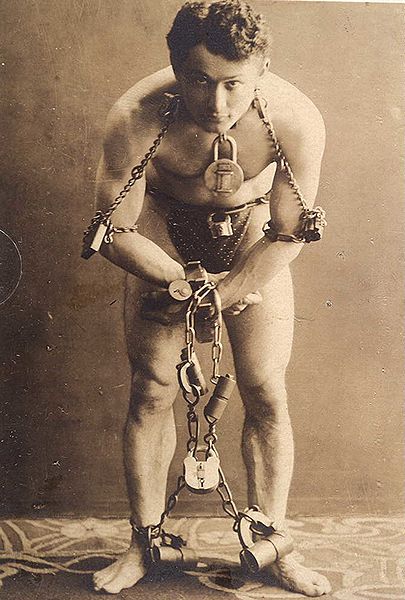Houdini: Art and Magic at the Jewish Museum
It is impossible to just look at the objects in Houdini: Art and Magic without projecting your own imaginations of the most famous escape artist. The exhibit currently at the Jewish Museum in New York chronicles the life of the Hungarian immigrant, who was born Ehrich Weiss in 1874 and died in 1926 as the iconic American Harry Houdini. The magic of that transformation is as incredible as any of his death defying stunts.
 Houdini is lowered in a packing case said to contain six hundred pounds of iron weights into New York Bay. He escaped in two minutes and fifty-five seconds. (Source)
Houdini is lowered in a packing case said to contain six hundred pounds of iron weights into New York Bay. He escaped in two minutes and fifty-five seconds. (Source)
I visited the museum on a Saturday (when there are free hours from 11 am to 5:45 pm) and was completely enthralled by the archival footage of Houdini’s feats, including upside down escapes from straitjackets and being thrown off a bridge in chains. The daring of his escapes, as well as their incredible simplicity, never becomes less impressive.

Harry Houdini (source)
The exhibit includes Houdini’s straitjacket, a wall of handcuffs, diaries, posters, theater ephemera, photographs, films, objects from his escapes, and contemporary art inspired by his legend. The art was a little hit or miss. A lot of it seemed to function more like decoration for the exhibit rather than adding anything to the experience. That said, a delicate, but dark, piece by Petah Coyne hanging in one gallery stood out as particularly beautiful, incorporating chains and other objects into a sort of decaying chandelier. The strangest piece was Matthew Barney’s installation Cremaster 5: The Ehrich Weiss Suite (Barney created the fantastically insane films in the Cremaster Cycle). It was a whole room visible through a glass door, where Jacobin pigeons strutted around on top of an acrylic coffin holding chains. The wall text said that the artist was making a comment on mortality and nature, but the flamboyant black and white feathered manes of the pigeons made me think more of an illusionist who, rather that die and turn into dust, was transformed into magician’s birds.

Water Torture Cell (source)
The son of a rabbi, Houdini immigrated with his family from Budapest to Appleton, Wisconsin, and ran away to the circus at 12 years old. The exhibit starts with his circus tricks of threading needles with his stomach, and progresses into his feats of escape. Magic apparatus are illuminated on pedestals, including a packing crate, milk can, and a recreation of the water torture cell where he was suspended upside down, the peril of drowning making his escape even more intense.
 Houdini’s Grave (source)
Houdini’s Grave (source)
Houdini died on Halloween in 1926, and was buried in Machpelah Cemetery in Queens in a bronze casket that had been used in an escape where he was buried alive. Each year, people gather at his grave on Halloween to try to make contact with the magician, to see if he finally escapes the final bondage of death.
Houdini: Art and Magic is at the Jewish Museum through March 27, 2011. After New York, the show will travel to the Skirball Cultural Center in Los Angeles, the Contemporary Jewish Museum in San Francisco, and the Madison Museum of Contemporary Art in Wisconsin.



Follow us on Twitter to get the latest on the world's hidden wonders.
Like us on Facebook to get the latest on the world's hidden wonders.
Follow us on Twitter Like us on Facebook